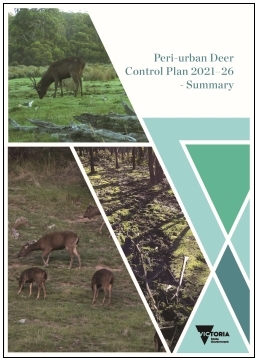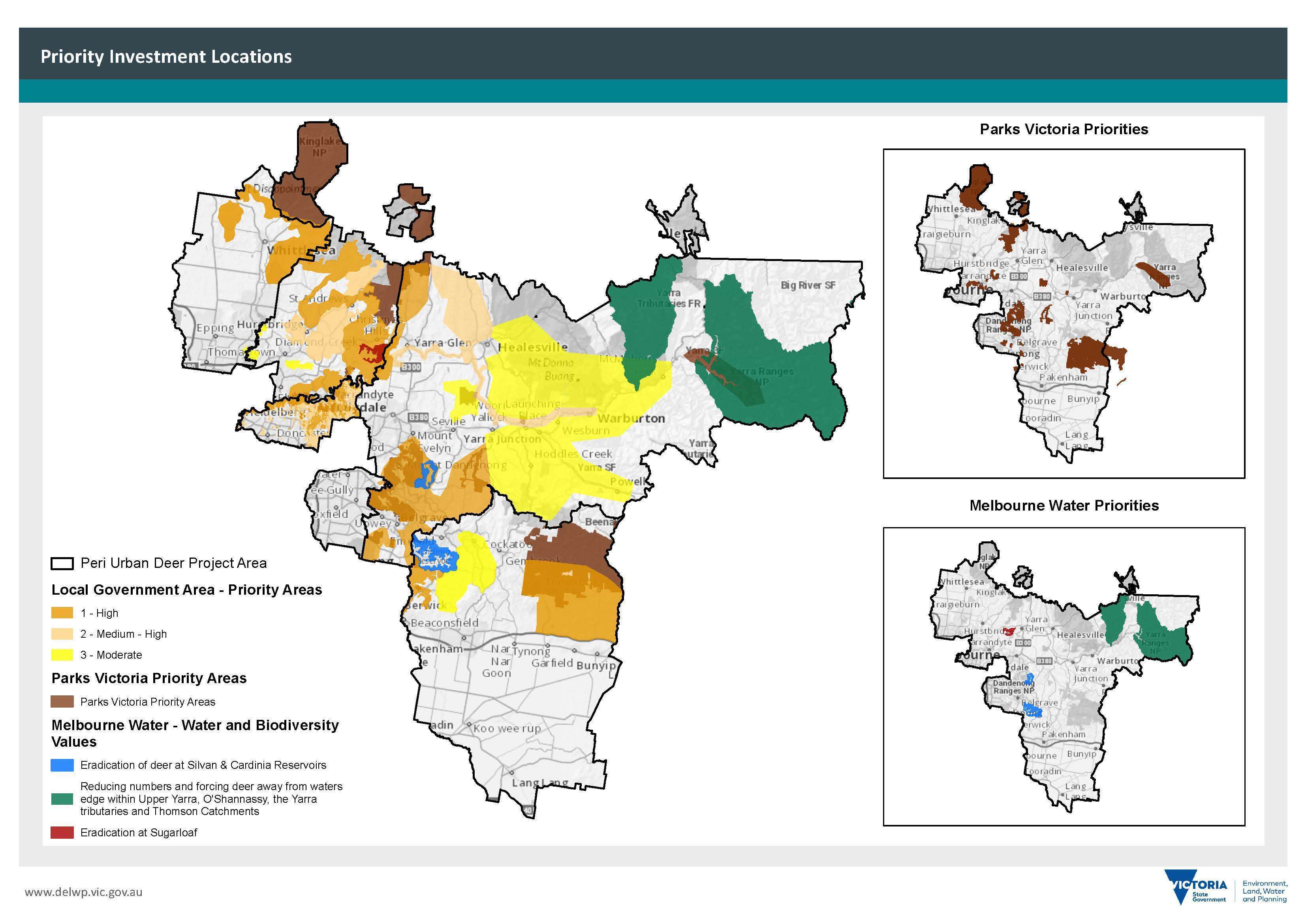 The Peri-urban Deer Control Plan 2021–26 (the Plan) is Victoria’s plan to reduce the impact of deer across the peri-urban region east and north of Melbourne.
The Peri-urban Deer Control Plan 2021–26 (the Plan) is Victoria’s plan to reduce the impact of deer across the peri-urban region east and north of Melbourne.
The aim of the plan is to have a consistent framework to guide investment and collaborative on-ground action for the greatest net benefit across multiple values and land tenure.
It is the first of three region-specific plans developed to address the state’s deer control response under the Victorian Deer Control Strategy (VDCS).
A wide range of environmental, economic, and social impacts have been attributed to wild deer in Victoria.
The most significant impacts identified in the periurban area are to the values of biodiversity, water quality, public safety, agricultural assets, and Aboriginal cultural heritage.
Modelling indicates that if we do not act, deer could potentially spread across Victoria. We are already seeing evidence of this in the peri-urban plan area.
The Plan was prepared in consultation with a regional partnership group made up of local partners and stakeholders involved and interested in managing deer impacts, including land managers, local government, conservation, industry, community groups and Traditional Owners.
The Plan will help partnership group members and the community develop local approaches to deer control.
Individual landholders can also use the Plan to guide cost-effective deer control and to contribute to monitoring where appropriate.
A Biosecurity Approach to Deer Control
The objectives of Victoria’s Deer Control Framework are to:
- prevent new deer populations from establishing in Victoria (prevention)
- remove isolated populations of deer (eradication)
- limit the spread of deer beyond their current geographic range (containment)
- protect and reduce the impacts of deer on priority values (asset protection).
The Victorian Government’s approach to biosecurity is based on the return-on-investment principle, whereby the greatest return on investment is realised through activities that prevent the entry and establishment of a species.
Where possible, prevention is the most cost-effective means of dealing with invasive species.
The benefit–cost ratio decreases as a species becomes more widespread.
In areas where deer have become established, containing the population and protecting assets may be the only options.
Identifying Priority Sites
The Plan identifies priority areas for government and community investment in deer control, as shown in the maps below.
The priority investment locations map is designed to be used with the prioritisation matrix (provided in the plan) to assess whether investing in deer control is worthwhile at specific locations.
DELWP, land managers and project managers can use these tools to identify cost-effective and strategic locations to carry out deer control, surveillance, and other management measures at a local level.
The prioritisation matrix helps narrow down the best sites for deer control both within mapped priority investment locations and at non-mapped sites if sufficient impacts on values and threats can be shown.

Improving Deer Control in the Peri-urban Area
This Plan identifies actions designed to be rolled out over the life of the plan (2021–26) to improve the control of deer in the peri-urban area.
The peri-urban deer control plan on a page provides a snapshot of goals actions and expected outcomes to be delivered under this Plan.
This Plan will be evaluated against the key performance indicators established for each of the actions.
In addition to the five-yearly review, the Plan will be updated as new information becomes available, which will be particularly important during the initial 12 months of the Plan’s implementation.
Vision, Goals, Actions and Outcomes
Vision
Deer are no longer significantly impacting priority environmental, agricultural, and Aboriginal cultural heritage values and public safety in Victoria.
To be achieved by working together to minimise the impact of deer across the Plan area.
Goals and Actions
1. The impacts of deer on key environmental, agricultural and Aboriginal cultural heritage values and public safety are reduced
- Undertake deer control and management activities in priority locations
- Develop collision register for deer-vehicle accidents
- Target high priority riparian waterways and water supply network sites
- Work with partnership members to support the use of deer carcasses
- Control deer before planting, revegetation or establishment of plantations and as ongoing activity
- Map deer fencing in the periurban area to support deer control planning
- Undertake a yearly review of the Regional Plan
2. Deer control is more effective through partnerships and community collaboration
- Build capacity to protect Aboriginal cultural heritage through Traditional Owners
- Review role of government in supporting standard accreditation process for shooters
- Hold yearly masterclass for deer control
- Increase community understanding of deer impacts and control options through collaborative programs
- Install demonstration deer fences and shooting platforms
3. Awareness, understanding and capacity to control deer is increased
- Develop and share deer density monitoring methodology for the peri-urban landscape
- Quantify impacts of deer on agricultural enterprises in peri-urban areas
- Develop and promote a Ground Shooting Standard Operating Procedure (SOP) for deer control in peri-urban areas
- Contribute to research priorities by identifying knowledge gaps
- Enhance citizen sciences for deer program
- Support mitigation measures including signs, deterrent devices, and media to reduce impacts of deer and increase community awareness of deer and control options
Outcomes
- Protect high-value biodiversity
- Protect agricultural enterprises impacted by deer
- Protect areas of cultural sensitivity
- Increase public safety by reducing deer collisions
- Protect water quality
Page last updated: 26/03/22